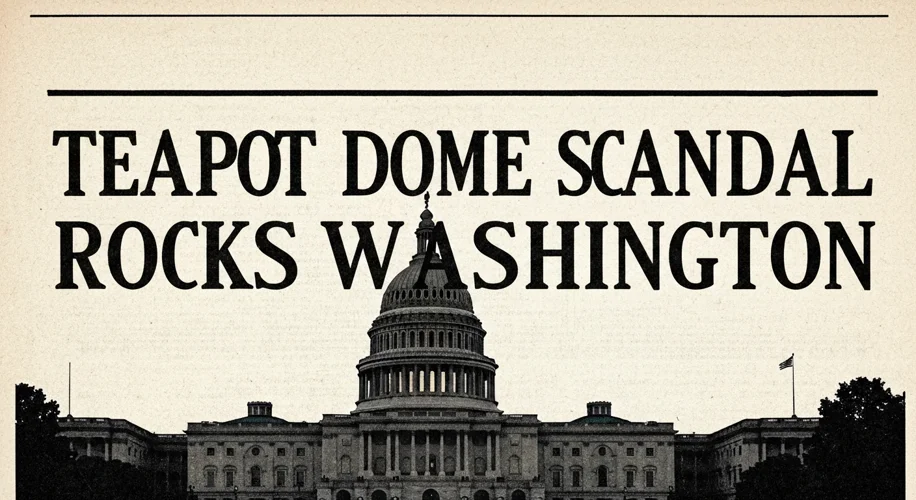In the annals of American political history, few scandals cast as long and dark a shadow as the Teapot Dome scandal. It wasn’t merely a tale of petty corruption; it was a seismic event that shook the very foundations of trust between the American people and their government, a stark reminder that even in the highest echelons of power, greed and ambition can run rampant.
The Roaring Twenties: A Decade of Excess and Ambition
The 1920s, often romanticized as the Jazz Age, were a time of unprecedented economic boom, cultural dynamism, and, beneath the glittering surface, a palpable undercurrent of moral laxity. Prohibition fueled organized crime, the stock market soared with reckless abandon, and a new breed of businessman, often with questionable ethics, sought to exploit the nation’s burgeoning wealth.
It was within this era of excess that President Warren G. Harding, a man more known for his affable nature and handsome looks than his sharp intellect, presided over a White House that became a hotbed of political intrigue and corruption. Harding, it is said, “had a mind like a shimmering, heat-haze on a July sidewalk – it seemed to promise something, but when you got close, it was just there.”
The Key Players and Their Desperate Game
At the heart of the Teapot Dome scandal stood Albert B. Fall, Harding’s Secretary of the Interior. A former U.S. Senator from New Mexico, Fall was a man of grand ambitions, deeply in debt and eager to enrich himself. He saw the vast naval oil reserves, specifically the Teapot Dome in Wyoming and the Elk Hills reserve in California, not as strategic national assets, but as ripe opportunities for personal gain.
His co-conspirator in this illicit endeavor was Edward L. Doheny, a powerful oil magnate who, along with his son Ned, was instrumental in securing lucrative deals. Harry F. Sinclair, the head of the Sinclair Oil Corporation, was another key figure, eager to access these protected government resources. These were men accustomed to getting what they wanted, using their immense wealth and influence to bend the rules, and in this case, to break them.

The Nefarious Leases and the Whispers of Bribery
In 1921, President Harding transferred the control of the naval oil reserves from the Navy Department to the Department of the Interior. This seemingly administrative shift was, in fact, the first domino to fall in a scheme designed to line Fall’s pockets. Without any competitive bidding, Fall secretly leased the Teapot Dome oil fields to Harry Sinclair’s company and the Elk Hills reserves to Edward Doheny’s Pan-American Petroleum Company.
In return for these remarkably favorable terms, Fall received a staggering sum of over $300,000 in “loans” and “gifts” from Doheny and Sinclair. These “loans” were, in reality, thinly veiled bribes, a blatant quid pro quo for the exploitation of public resources. Imagine the scene: clandestine meetings, hushed conversations, and the clinking of champagne glasses as fortunes were made on the backs of national security.
The whispers of corruption began to spread like wildfire. Senators like George W. Norris of Nebraska, a staunch progressive, grew suspicious of the suspiciously low rates and the lack of public oversight. Their persistent inquiries, often met with stonewalling and obfuscation from the Harding administration, ignited a firestorm of public interest.
The Unraveling: Investigations and the Fall of Innocence
By 1923, the pressure became too great. The Senate launched a full-scale investigation into the leasing of the oil reserves. Chaired by Senator Thomas J. Walsh of Montana, the investigation committee meticulously pieced together the evidence of bribery, conspiracy, and a monumental betrayal of public trust. The hearings were a dramatic spectacle, broadcast across the nation, revealing the sordid details of Fall’s corruption.

The scandal was further exacerbated by the untimely death of President Harding in August 1923, just as the investigation was gaining momentum. While Harding was never formally charged, his administration became irrevocably tainted by the stench of corruption. His successor, Calvin Coolidge, was keen to distance himself from the scandal and vowed to restore integrity to the White House.
The Aftermath: Justice Served, But at What Cost?
The consequences of the Teapot Dome scandal were profound. Albert B. Fall was eventually convicted of bribery and sentenced to a year in prison, becoming the first U.S. cabinet member to be incarcerated for crimes committed while in office. Edward Doheny and Harry Sinclair were acquitted of bribery charges, though Sinclair served a brief jail sentence for contempt of the Senate.
More importantly, the scandal led to the creation of the Federal Oil Conservation Board and spurred a greater public awareness of the need for transparency and accountability in government. It demonstrated that the nation’s natural resources were not commodities to be bartered by corrupt officials but sacred trusts to be managed for the benefit of all.
The Teapot Dome scandal served as a stark, unforgettable lesson. It exposed the fragility of public trust and the insidious nature of corruption when unchecked. The echoes of Teapot Dome continue to resonate today, a perennial reminder that vigilance, integrity, and a commitment to public service are not mere ideals but essential pillars of a healthy democracy.
It was a scandal that, for a time, made Americans question the very fabric of their government, a dark chapter in the Roaring Twenties that underscored the enduring struggle between the forces of greed and the pursuit of justice.

